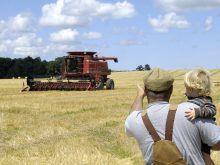The May long weekend traditionally signals the start of gardening
season on the Prairies. Now that you’ve made your selections, ask
yourself this: what does my garden say about me this year?
Every flower is said to have a meaning. Some say the language of
flowers was devised in Victorian times, though it may go back to the
Shakespearean era. Along the way, somebody took it upon themselves to
assign meanings to other vegetation too, and there is a wealth of
Read Also

Crop profitability looks grim in new outlook
With grain prices depressed, returns per acre are looking dismal on all the major crops with some significantly worse than others.
information on the internet.
So, out to the garden and what do we see? Thistle, dandelion,
chickweed, brambles, dead leaves? Not at all. What we have here is a
crop of austerity, faithfulness, ingenuous simplicity, remorse and
sadness.
Just dig the sadness under. It makes good compost.
Maybe you’ve succeeded in replacing this weedy emotional stew with rows
of vegetables. Maybe potatoes, turnips, parsley, cabbage, rhubarb,
corn, cress, cucumbers and lettuce? Think again. You’ve planted
benevolence, charity, useful knowledge, gain, advice, riches, power,
criticism and cold-heartedness.
Remember, it’s not too late to plant more corn and less lettuce.
What have we in the herb garden and field? Mint, rosemary, coriander,
sage, yarrow, borage, oats, flax? In that case, you’ve planted virtue,
remembrance, hidden worth, domestic virtue, healing, bluntness, music
and domestic industry.
On to the planters and flowerbeds, fraught with foliar faux pas. Those
cheerful marigolds? Despair. Colourful candytuft? Indifference.
Graceful columbines? Folly. Pretty lobelia? Malevolence.
But never mind those. Move on to the lily of the valley, signaling the
return of happiness, and the sweet pea, which means blissful pleasure.
Notice the nasturtiums, signifying victory, and the crocus that brings
cheer.
Plant pansies for thoughts and petunias for soothing presence. Mingle
with ferns for honesty and lupins for imagination.
Be sparing with haughty sunflowers and presumptuous snapdragons. But be
generous with the finesse of sweet william and the worth beyond beauty
of alyssum.
The adventure continues in the wider, wilder world, where gorse means
enduring affection and goldenrod means success. Cheerful buttercups are
associated with childishness, vetch with shyness and cattails with
peace and prosperity.
Finally, growing amid brambles, thrusting from amongst rocks and
blooming bravely from roadside ditches, we find the wild rose.
Simplicity.
Don’t you love the growing season?















